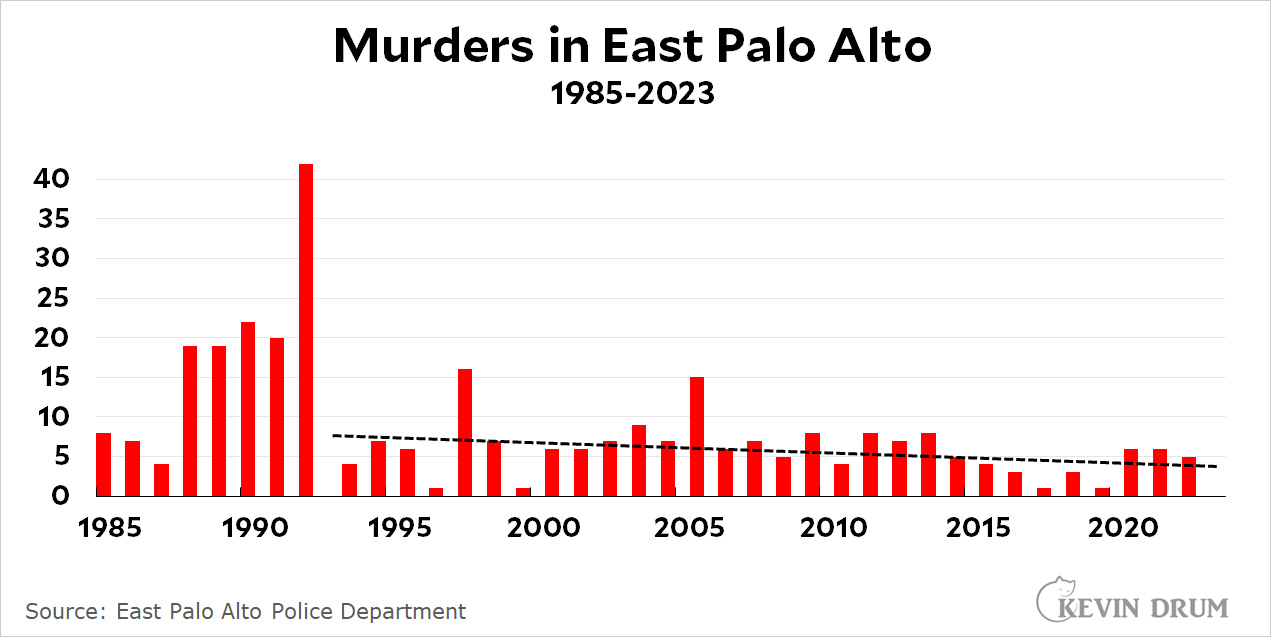The LA Times has a story today about the miracle of East Palo Alto:
In 1992, East Palo Alto was dubbed the “murder capital” of the U.S., with 42 murders in its 2.5 square miles — a per capita rate higher than that of any other city of any size. In 2023, according to East Palo Alto Police Department statistics released last week, the turnaround seemed complete: zero homicides.
Law enforcement leaders, residents and city officials point to a complicated mix of circumstances that turned a crime-ridden community into what the mayor now calls “one of the safest places to live in the peninsula.”
That's amazing! How did they do it?
Well, the median income in East Palo Alto is now $103,000, but naturally city officials insist that's not the reason. They always do. The reason must be some set of policies that they themselves have implemented.
But put that aside. I had to read past the jump to finally find out what's going on. Here is a chart of murders in East Palo Alto:
 East Palo Alto had a high murder rate for a few years in the late '80s and that was about it. The very next year after their record 42 homicides they recorded.......4.
East Palo Alto had a high murder rate for a few years in the late '80s and that was about it. The very next year after their record 42 homicides they recorded.......4.
And the trendline since 1993 shows a slow decrease from about 8 murders a year to 4. That's no miracle. That's just East Palo Alto getting richer plus the effects of lead reduction that affected murder rates in every city in the country.
If the city fathers of East Palo Alto want to crow about having zero murders in 2023, that's fine. They deserve a round of applause. But there's no excuse for the Times getting suckered into covering it.

I lived in Menlo Park at that time in the late 80's/early 90's, and you are correct. It's the income. Prices were going nuts in Palo Alto, but US 101 separates Palo Alto from East Palo Alto. That was enough to stop a diffusion of gentrification into East Palo Alto, and make it more like a potential barrier that had to be overcome. But during the early 90's it was very obvious that potential barrier was going to be overcome soonish, and then there was going to be this shock wave of development/gentrification that was going to burst through. I also have this vague memory of East Palo Alto about to pass a set of tax incentives/zoning law changes to encouraged that wave of development right around the early 90's.
But yeah, when nearly every small house & lot in Palo Alto was going well over $1M (slightly more than double that or so for today's dollars), there's only so long people were going to pass up few $100K opportunities just a mile or two away, despite the crime rate.
Doing a quick look online at current prices in the neighborhood, the 3 bedroom we had in Menlo Park for $2500/month (today's dollars) would probably be in the $5K-$6K range today. That kind of price pressure just outside of the East Palo Alto borders was eventually going to win out.
Exactly.
This is where Ikea is.
The only reason it was bad in the 80s was that Palo Alto decided not to share any of its tax base, and there basically wasn't any government funding for East Palo Alto.
The existence of funding and policing changed after the spike in murders brought shame on the county and state patrol which had been ignoring vast swaths of the state.
Given basic governance, things actually work out.
Given basic decency, the need for basic governance is minimized.
We moved to Menlo Park in 1981. We were looking for apartments in the Palo Alto/Menlo Park area and saw a listing that looked pretty reasonable in East Palo Alto. We didn't even stop our cars when we drove up. After a few years we thought about buying a house and the only things remotely in our price range were in or near East Palo Alto. It was about the only place on the Peninsula that was affordable. That many high income DINKs were going figure it out eventually.
I lived in East Palo Alto for a bit over two years, from 1985-1988, and saw this developing. East Palo Alto became an actual city only in 1983, having been unincorporated county land before that. In those first few years the police force was single digits of officers sharing only one or two cars, and the streets became a popular place to sell drugs... and in a few years, a turf war broke out. Most of the murders were drive-bys of rival dealers, with the main body of the war happening in 91-92, as the numbers would indicate.
When they busted "the biggest heroin ring in the Bay Area" running out of an apartment complex a block away from me, I scraped together enough to get away to far south San Jose and an apartment not in a war zone. That did explain a lot about the crowd at the 7-11 across the street, though.
Somewhere in the (early) 1990s “Whiskey Gulch” got redeveloped and as mentioned elsewhere, IKEA came-in later. I suspect that is when the shopping center across from IKEA was (re)done, and of course in the early 90s “Sun Quinton” (employee moniker, later Facebook arrive just across the line, in Menlo Park.
The/any involvement of lead seems to have been minimal. The drop was too sudden and large.
Relevant articles, supporting what others point out: this was about city incorporation, then drug wars.
https://www.latimes.com/archives/la-xpm-1993-01-05-me-833-story.html
https://www.nytimes.com/1988/07/03/us/2-california-cities-share-grief-over-slain-officer.html